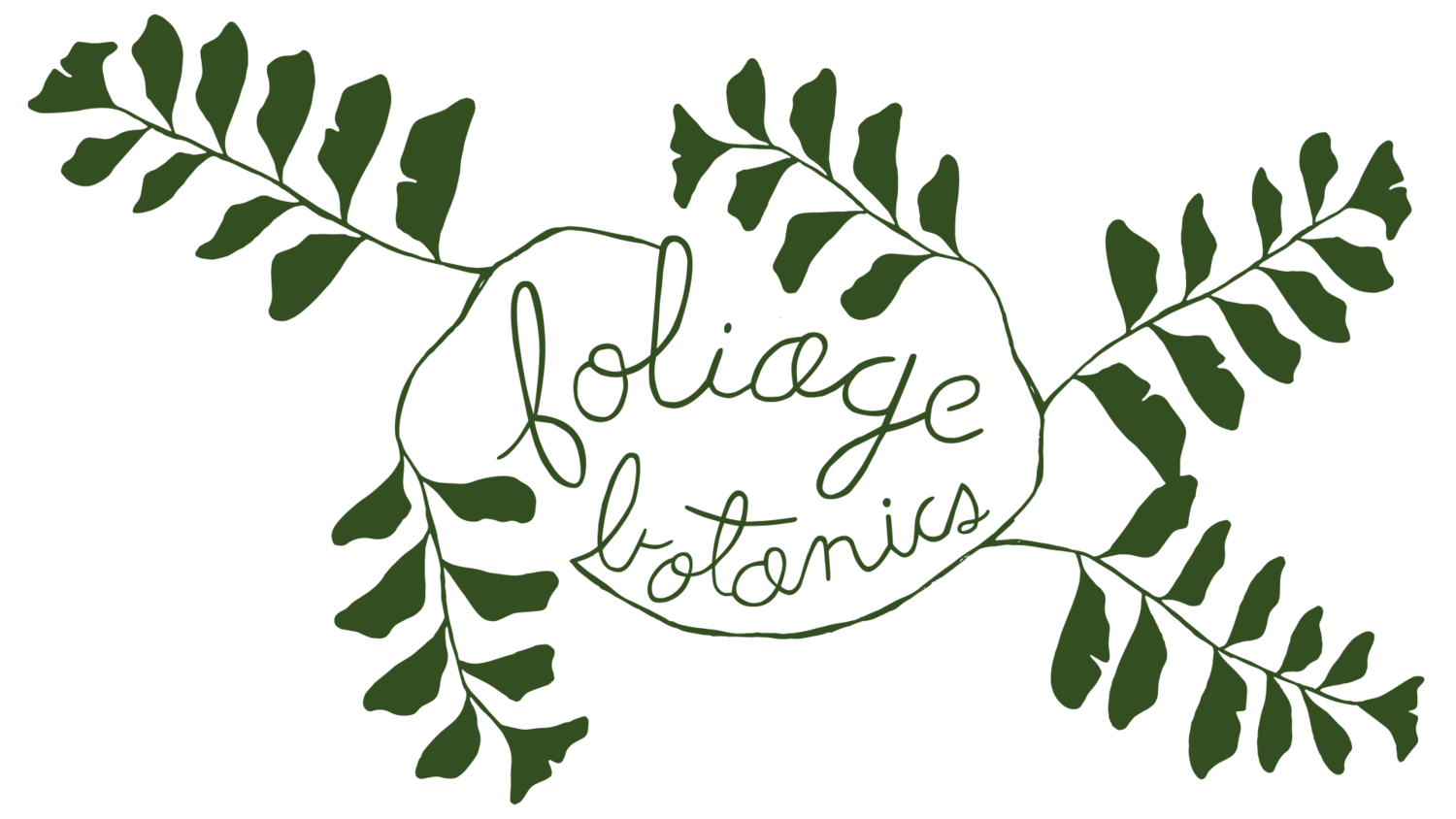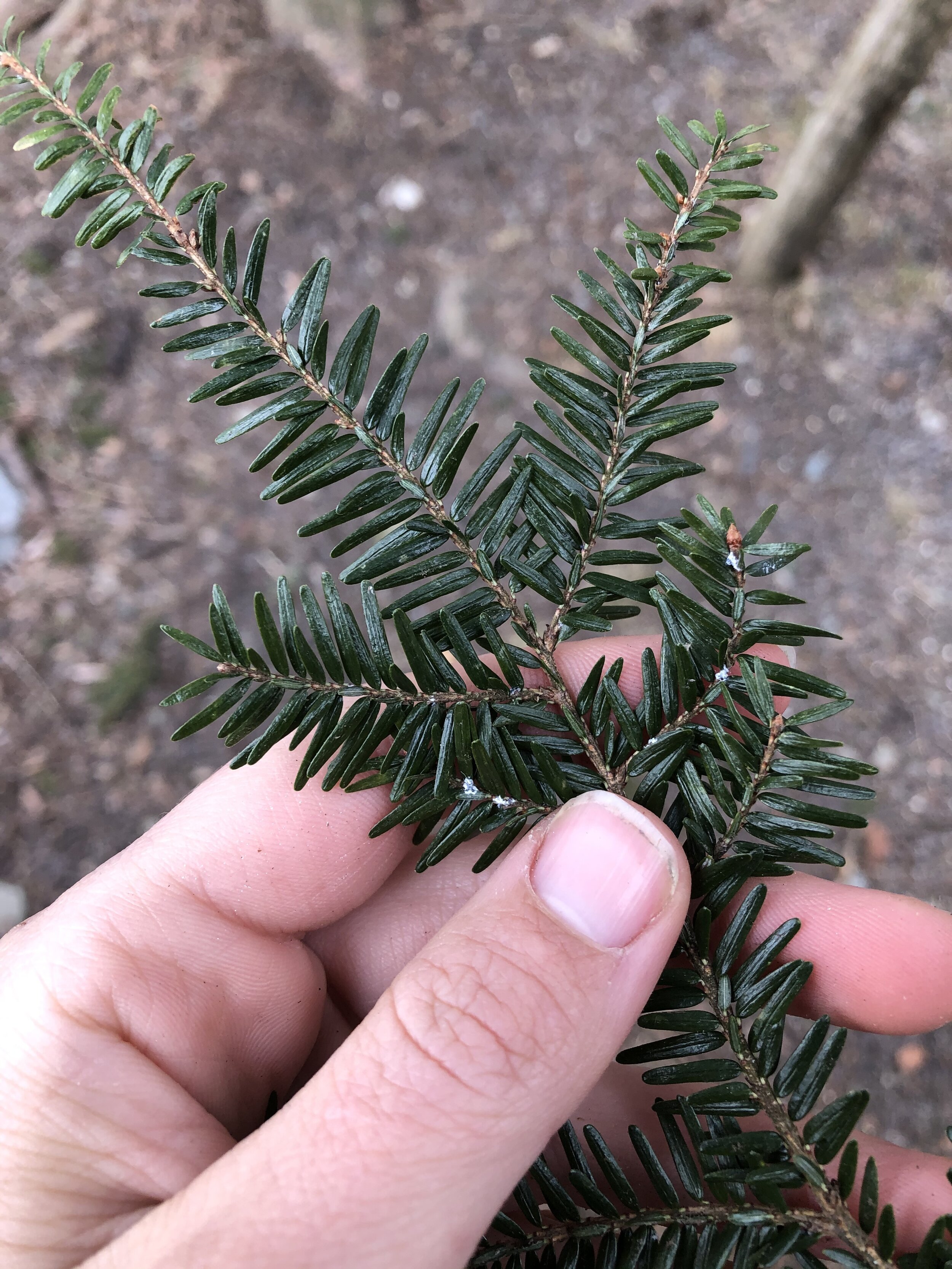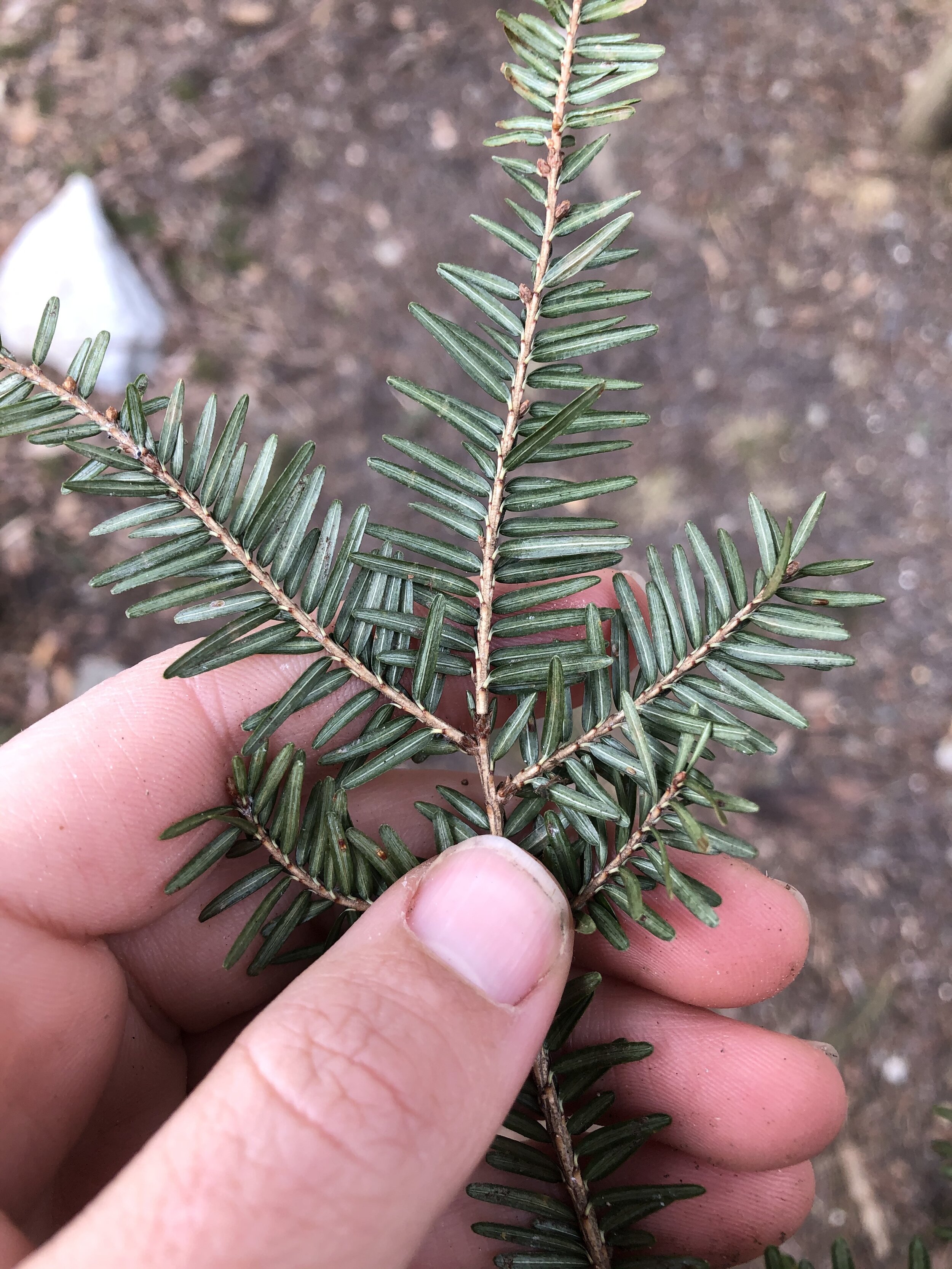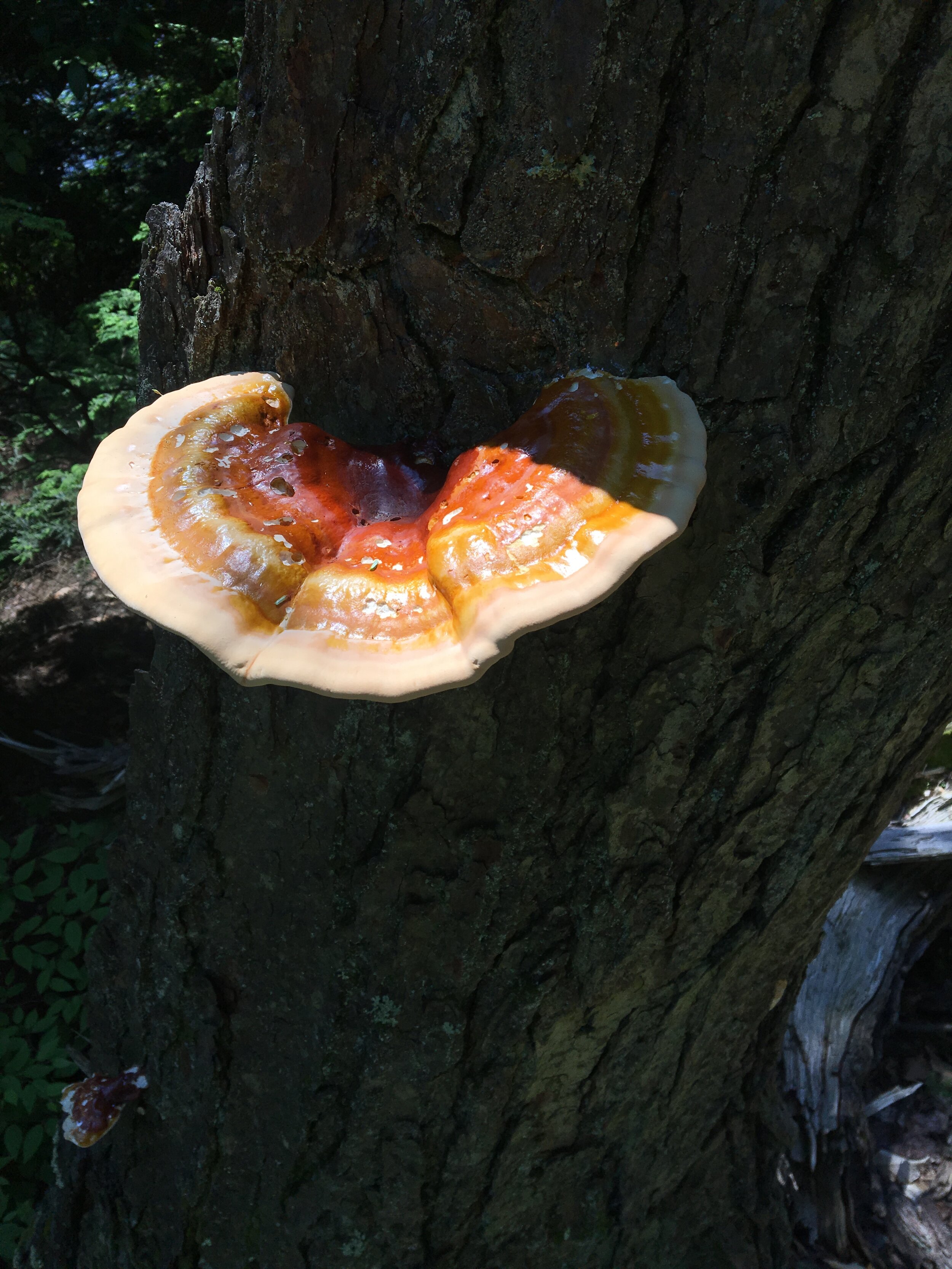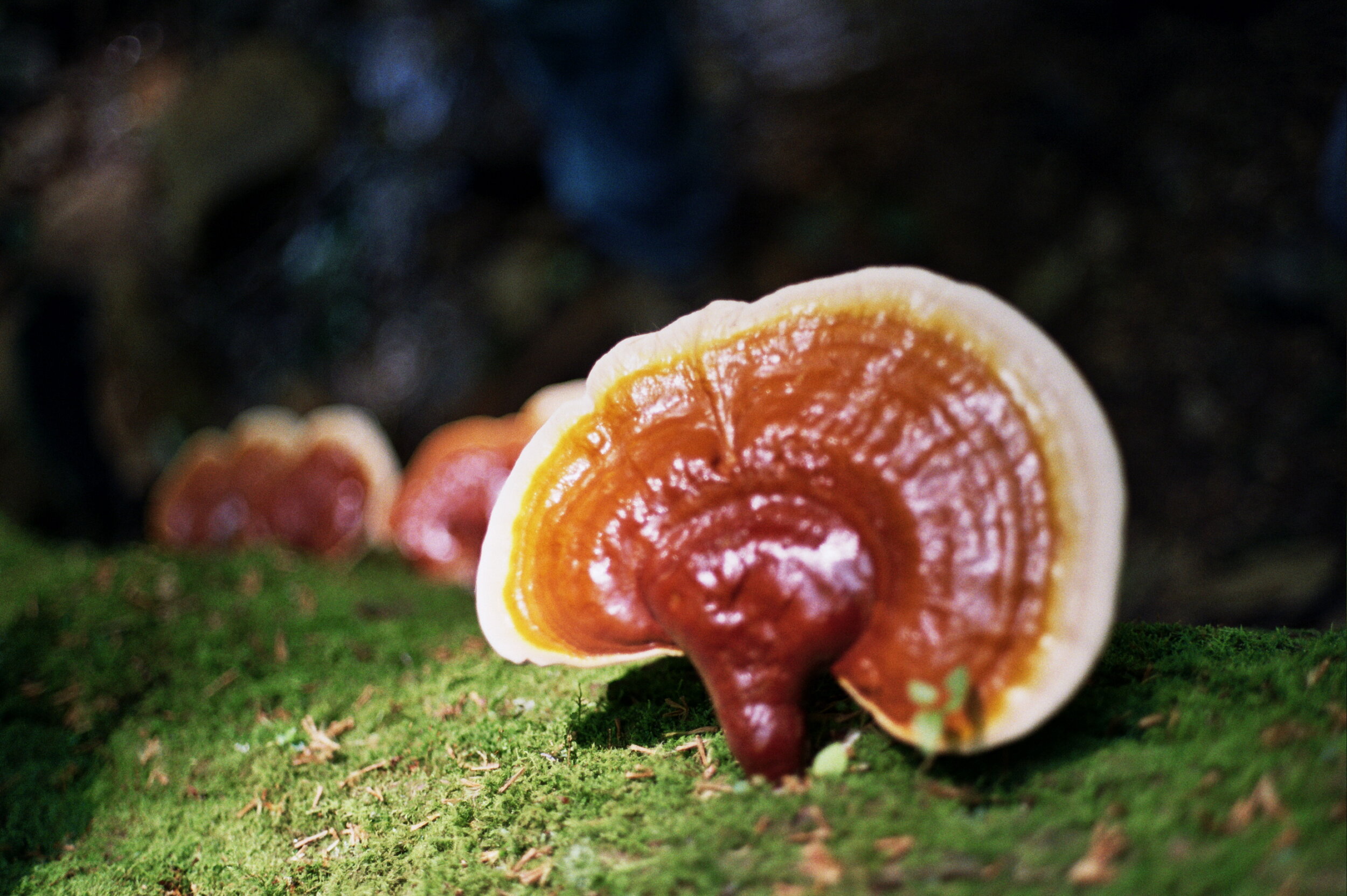Hemlock Plant Profile
Walking through a hemlock grove is like nothing else here in the east. Suddenly the woods get a little quieter, darker as you enter, the ground underfoot softer and more open. There’s a great hush that seems to fall upon you, inside and out—maybe it’s the way the wind blows through the massive sweeping branches or the light dapples through their feathery silhouettes or the unmistakeable sensation of your feet pushing through layers of tiny rusted needles settled silently on the forest floor accompanied by the low eery hooting of the barred owl hidden up in the dark canopy above. Or maybe its just their majestic nature, often the oldest and largest trees in the woods, huge and dark-trunked, branches like great lacey curtains closing you in, a tree that so very much feels all-knowing, the great god of the eastern forest.
My first encounters with hemlocks were down south in North Carolina where I went to college where already in 2009, death had become synonymous with this tree species. In the blue ridge and smokey mountain sections of the Appalachians some of the largest hemlocks on record have been found, some 700 years old, towering at over 150 feet tall and 5-6 feet in diameter. These southern swaths of hemlock woodland were the first areas to go. There’s this place I loved to hike when I lived there called Linville Gorge where every trail led you down a harrowing mountain side through thick rhododendron tunnels and hemlock-dense woods, down single-file foot-beaten paths woven with their knobby, shallow and exposed root systems to the most pristine ice-cold river. Over the course of my years in North Carolina, returning to this gorge, the trees have almost died out completely, once a mountain side of thick lush green now a dried out dusty slope riddled with rust-colored ghosts.
Lately I’ve been thinking about climate change with a kind of desperation, and this tree, these hemlock-dominated sections of the woods are the places I run to. For consolation, perhaps? For a personal reminder of the significance of things? For answers? In New York these ecosystems are still relatively intact, but not for long. and the significance of their loss in the south and their imminent demise here up north if things don’t shift—well, it’s almost unspeakable. So, I wanted to write about these incredible trees and their multitude of purposes in the ecology of things, touching on botany and identification, value in the larger ecosystem, uses, and then of course the story of their decimation, all in hopes that by sharing their story, some folks might be inspired into appreciation and exploration and perhaps then into action.
Botany
There are a few different species of hemlock tree. The one I’m writing about specifically is the eastern hemlock, Tsuga canadensis. There is a western hemlock as well, which as its name implies, grows out west, with different characteristics, growth habits, and a different story really entirely. The other species that does grow out east is the Carolina hemlock, Tsuga caroliniana. This tree grows at high elevations in the southern Appalachians and is also affected by the HWA (more about this down below), has some botanical differences and pretty different growing conditions, preferring high, dry soil, and growing well in full sun. There’s another “hemlock” people think of that is not a tree—water hemlock or poison hemlock, which is in the Apiaceae or carrot family, not a tree, but a water-loving herbaceous plant with umbelliferous flowers (like dill or Queen Anne’s lace flowers, for reference). So, not related at all except in whatever way the early “discoverers” and botanists saw some similarity so as to give them similar common names. Maybe the smell? Or the feathery-ness of the branches reminding them of the feathery leaves of the water hemlock? I’m not sure.
Eastern hemlock trees grow mostly along waterways, often on the hillside leading down to a stream or brook of some kind, with shallow root systems that rely on acidic, moist, cool ground. In the south they grow alongside other acid-loving darkness dwellers like the aforementioned rhododendron, but up north it’s often a solid block of hemlocks with little undergrowth, maybe a few oaks or black birches interspersed in the grove. The bark is dark brown, thick, and deeply furrowed and the tree is evergreen, in the pine family (Pinaceae), with short flat, blunt needles about ¼ to ½ inch long. The needles are rounded at the tip, dark green, and flat, with two thin parallel white lines running the length of the underside. These white lines are actually two lines of many tiny stomata—minute pores out of which the leaves exchange gases or breathe. If you look very closely, the margins of the needle are serrated with many tiny teeth. The cone, which matures in October, are quite small as well, about ¾ inch long, light reddish brown and delicate, and hang down at the very tips of the feathery branches like small silent bells.
The delicate bell-shaped hemlock cones. This is a pretty identifying feature as the hemlock has some of the smallest cones of all conifers in the eastern forest.
The branch shape and structure is pretty loose and chaotic, giving the whole tree silhouette a kind of feathery appearance. As you can see in this picture and the two above, the top of the needles are darker green and glossy, while the underside are lighter with those distinct white lines and a more matte appearance.
There are a number of other conifers with which the hemlock could be confused, but here are some descriptions of those trees to elucidate how the hemlock differs:
White Pine: has long needles in circular bundles of 5, hemlock needles are much shorter and grow individually off the twig.
Red spruce: has sharp-pointed needles. These needles are also 4-sided, rolling between your fingers, not flat like the hemlock’s, and the way they grow all around the twig gives the spruce a prickly nature when you try to grasp it, a characteristic hemlocks don’t share. Spruce cones are also much larger and longer, sometimes 6 inches in length.
Tamaracks: these needles are short, but grow in clusters like the white pine, with 10 to 20 needles in a bunch. Tamaracks (also called larches) aren’t evergreen either, our only deciduous conifer in the northeast. The needles turn yellow in the fall and fall off by winter.
Balsam fir: this is the trickiest tree to distinguish the hemlock from, in my opinion. Balsam needles are flat and white-lined as well, also growing along a horizontal plane giving the branches a very flat appearance. Hemlock needles, however, are attached to the twig by tiny slender stalks; balsam fir needles are not stalked. The greatest difference though is in the cone—hemlock cones are pendant, while balsam fir cones stand upright and rarely fall from the tree whole. The silhouette of the fir is quite conical also, the hemlock a little more loose and droopy. Lastly, fir bark often has noticeable resin blisters; hemlock bark does not.
A handout I made a little while ago for The Bones We Collect letter project depicting some of the common evergreen conifers around where I live in New York. It’s a nice little cheat sheet for seeing at least some of the potential hemlock look-alikes you might see and how they differ. Maybe the most distinct here is the juniper or eastern red cedar whose leaves aren’t in needles, rather are scaled and whose cone is encased in a blueish skin, making it look more like a berry than a cone. The most similar is the balsam fir on the top left of the image, but you can see its longer needles and much larger, darker, and more upright cone!
The value of the hemlock, as much as the peaceful respite it provides soothes my soul personally, lies primarily in what it contributes to land, water, and wildlife. The hemlock profoundly affects water dynamics across eastern mountain ecosystems. These cool dark woodland coves they create along stream banks moderate water temperatures, regulate stream flow, minimize nitrate and nutrient run-off and provide natural erosion control, thus improving water quality. There is a great correlation between the presence of hemlocks and the health of the American brook trout, one of our native endangered freshwater fish species, which is very sensitive to high temperatures, poor oxidation, and pollution, all things the hemlock tree was basically designed to remediate.
Hemlocks also act as a significant habitat feature for many other animals. Their dense, low branches provide cover and protection (especially in winter) for grouse, wild turkey, white-tailed deer, porcupines, among many. Many of these animals feed on the bright green foliage and twigs and the seeds are a huge source of food for red squirrels, mice, voles, other rodents, and many songbirds. Some birds of note who use hemlock habitat for breeding and feeding: yellow-rumped warblers, white-winged crossbills, dark-eyed juncos, evening grosbeaks, pine siskins, goldfinches, and my personal favourite, the wood thrush.
Human use of the hemlock has been varied over the years. As a medicine it has been used similarly to other pine family trees—as a warming, cold remedy; an astringent antiseptic for wounds. The needles are high in vitamin C and so make a nice nutritive winter tea and have been known to be used in native American pemmican recipes, a mix of plant material, dried fruit and fat eaten for a dose of high energy. The green unripe cones of hemlocks are amazing as a spice, with a kind of sharp citrusy flavor that I really love.
As far as lumber, the hemlock was always deemed lesser in value than white pine and so used less for bigger-scale construction originally, more pulpwood and mulch and paper and such. But with the over-harvesting of white pine, I think its use in building has steadily increased. I know the western hemlock is now overwhelmingly used, and that I believe is due to the diminishing population of eastern hemlock and its subsequent protection.
The high tannin content of hemlocks (which is also what gives it that astringency so good for wound healing and tissue repair) is what made it a huge component of the leather industry for a long time, used to “tan” the leather—now mostly synthetics are used, but I do know plenty of primitive skills folk who bark-tan on a small scale, soaking their pelts in a tannin rich tea containing hemlock bark.
In terms of use now, I advocate for mostly leaving all hemlocks be. Due to its endangered status, and the potential that certain hemlocks have been injected with chemical pesticides to save them from extinction, it’s important to recognize that the irreplaceable value of it for wildlife and waterways outstrips our human need for the wood or the medicine. As I mature in my role as a “plant person” I’ve grown more and more away from the attitude of learning about plants for their human use and my own personal application, because honestly, look where that’s gotten us. I could go on about this, but I’ll just say that I am a keen promoter of the value of plants resting in something much greater than our use and their role and purpose in the ecosystem prevailing over their role in ours. Hemlock has a medicinal history that is interesting, but with the severe pressure it is already facing, we can adjust to using it minimally (if we know there has been no chemicals used on it, especially for internal use, this is so important!) and find alternatives.
The severest pressure the hemlock faces is a foreign insect called the Hemlock Woolly Adelgid, which, introduced into the southeast in the early half of the 20th century, has already infested over half of the eastern portion of the hemlock’s range. These adelgids establish themselves at the base of the needles and feed on the tree’s own nutrient-dense cellular fluid, which causes defoliation, which then eventually leads to death of the whole tree. When you look at the underside of the hemlock branch and needles, if the adelgids are present you’ll see clusters of these white fuzzy sacs, which are their egg sacs. It typically takes a few years once infested for the trees to totally succumb, but you’ll start to see signs and symptoms pretty immediately of the stress it causes the tree to be so parasitized.
The adelgids are the leading cause of the decimation of the hemlocks in the southern range and are quickly moving northward. So far, the northeast has fared pretty well, but with climate change we stand to see both the reduction of suitable habitat for the hemlock (increasing temps, increasing deer population, etc. etc.) and expansion of the woolly adelgid’s. For this reason we have to be extra careful about transporting hemlock and any adelgids that might hitch a ride, especially up north where there are pockets and communities of the tree that have yet to be contaminated.
The college I went to in NC (Warren Wilson) had this long-standing tradition of handing you a small hemlock sapling on your way across the stage as your graduated and collected your diploma. The hemlock, such a ubiquitous tree in those rich, wet woods around there, has for a long time been the emblem of the college, the mascot, if you will. Hence the hemlock gift. My graduation year we were the first to not get a hemlock sapling because of the danger of us all taking a small slice of imminent death to one of the yet untouched corners of the country. We got Norway spruces instead.
I can’t really say there’s any positive outcome of the destruction of the hemlocks. I don’t tend to be the really negative, apocalyptic type either—I have a generally more positive regard for the “invasive” species, not necessarily glorying in their presence, but acknowledging their presence as a result of our human impact, a careless one often, but a perspective that challenges me to utilize and navigate those plants with care, curiosity, and without the othering language of alienation that we don’t use for ourselves despite our being just as alien, just as invasive (if not more!). But with hemlocks and the adelgids, it’s a little harder for me. The only thing I can add to this conversation that gives it a more fascinating twist is the native reishi mushroom that grows on dying and dead hemlocks.
These mushrooms are completely beautiful, a shelf mushroom and much thicker and tougher than, say, a chanterelle or oyster, with these shiny layers that fade from dark red-brown into egg yellow into a creamy white. The more well-known reishi mushroom, Ganoderma lucidum, is native to Asia, and has for a long time revered for its medicine. Not a tender thing, the mushroom is chopped up and decocted (heavily boiled) into tea and is used as a deep immunity and wellness tonic in Traditional Chinese Medicine. The North American hemlock reishi is said to have similar medicinal properties, gathered and used in tea blends and tincture to fight cancer and autoimmune conditions as well as just general immune system well-being. It’s what herbalists call an “adaptogen,” working to create harmony and balance is the body primarily through hormonal balance. I won’t dive too deeply into reishi medicine, but it is fascinating to me how the plant world seems to have a strange way of balancing or providing. Like with another aggressive non-native (a friend of mine calls all these plants “overabundant and underutilized” instead of invasives and maybe her strongest descriptor is “problematic,” which I like), Japanese knotweed, a known anti-spyrokete medicine and so used to address the ever-burgeoning Lyme disease, spreading through the waterways of all the places so deeply affected by Lyme—it’s all pretty fascinating. Below are some photos from the years of Ganoderma tsugae, our North American reishi, blossoming from the death in the hemlock woods.
Little reishi mushrooms bubbling out of a dying hemlock at my beloved Linville gorge, June 2016.
My dear friend Kelly and a massive reishi we found in the deep woods of Big Ivy, July 2016. This is the best stage to harvest the reishi for use, once it has matured into a full red-brown, has sporulated (reproducing), but is not yet destroyed by bugs and rain.
References:
https://blog.nature.org/science/2014/07/23/can-integrated-pest-management-save-the-eastern-hemlock/
https://theblueridgehighlander.com/hemlock-gift-giver-of-the-standing-people.php
https://stlawrencelowlands.wordpress.com/2012/11/05/eastern-hemlock-tsuga-canadensis/
https://wildadirondacks.org/trees-of-the-adirondacks-eastern-hemlock-tsuga-canadensis.html
Really interesting map depicting adelgid range: https://www.maine.gov/dacf/mfs/forest_health/insects/hemlock_woolly_adelgid_overview.htm
https://www.americanforests.org/magazine/article/the-last-of-the-giants/
